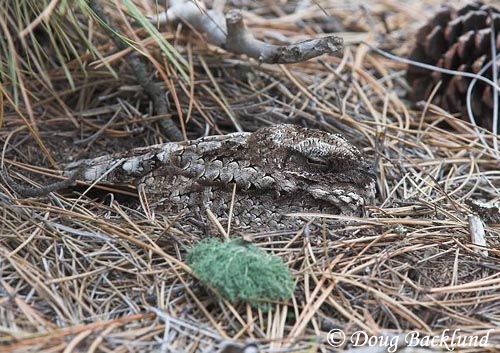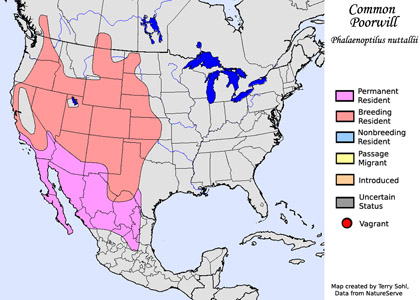Common Poorwill
Phalaenoptilus nuttallii
| Length: 7 to 8 inches | Wingspan: 11 to 13 inches | Seasonality: Summer |
| ID Keys: Short tail with white-tipped outer feathers, mottled gray-brown body, white band on throat, smaller than other nightjars. | ||
 The Common Poorwill is the
smallest of the "nightjars" in North America, and is considered the
western counterpart of the eastern Whip-poor-will. The Hopi name for the
Common Poorwill means "the sleeping one", as they are the only bird
known to hibernate. Some remain throughout the year in the Southwestern
U.S., but in cold weather, they enter a hibernating state with a lowered body
temperature, heartbeat, and rate of breathing. They may stay in this state
for days or weeks at a time.
The Common Poorwill is the
smallest of the "nightjars" in North America, and is considered the
western counterpart of the eastern Whip-poor-will. The Hopi name for the
Common Poorwill means "the sleeping one", as they are the only bird
known to hibernate. Some remain throughout the year in the Southwestern
U.S., but in cold weather, they enter a hibernating state with a lowered body
temperature, heartbeat, and rate of breathing. They may stay in this state
for days or weeks at a time.
Habitat: Can be found in a variety of dry open habitats, such as grassland with scattered shrubs, scrubby areas around dry open forests, desert canyons, and dry lowland hills and washes of the West.
Diet: Exclusively insects, especially moths, beetles, and other night-flying insects.
Behavior: Forages by observing from a low perch or on the ground, and flying up to catch flying insects that are passing by. Primarily feeds near dawn and dusk.
Nesting: June
Song: Mournful whistle, poor-WILL, with the second note higher in pitch.
Migration: Summers throughout the western half of the United States. Winters in the extreme southwestern U.S. and points south.
Interactive eBird Map: Click to access an interactive eBird map of Common Poorwill sightings
Similar Species: Whip-poor-will
Conservation Status: Populations are generally stable throughout its range.
Further Information: 1) Patuxent Bird Identification InfoCenter, Common Poorwill
3) Audubon Guide - Common Poorwill
Photo Information: Photo taken in North Cave Hills, Harding County by Doug Backlund.
| Click on the map below for a higher-resolution view |
 |
| South Dakota Status: Uncommon summer resident in the western part of the state, accidental in the east. |
Additional Common Poorwill Photos (coming soon!)
